Cell is a very important topic in biology. A cell is the basic structural and functional unit of all living organisms. It is the smallest unit of life that can carry out the processes necessary for an organism’s survival, including metabolism, growth, and reproduction. Cells can vary in shape and function, but they all have common features, such as a cell membrane, cytoplasm, and genetic material (either DNA or RNA).
Cells can be categorized into two main types: Prokaryotic Cells, which lack a distinct nucleus, and Eukaryotic Cells, which have a true nucleus enclosed within a membrane. Here we have briefly described the Prokaryotic Cell.
Prokaryotic Cell
A prokaryotic cell is a type of cell that lacks a true nucleus and other membrane-bound organelles. Prokaryotic cells are typically smaller and simpler than eukaryotic cells, which have a defined nucleus and various membrane-bound structures like mitochondria and endoplasmic reticulum. Prokaryotes include bacteria and archaea, and their genetic material is typically found in a region called the nucleoid, which is not enclosed by a membrane.
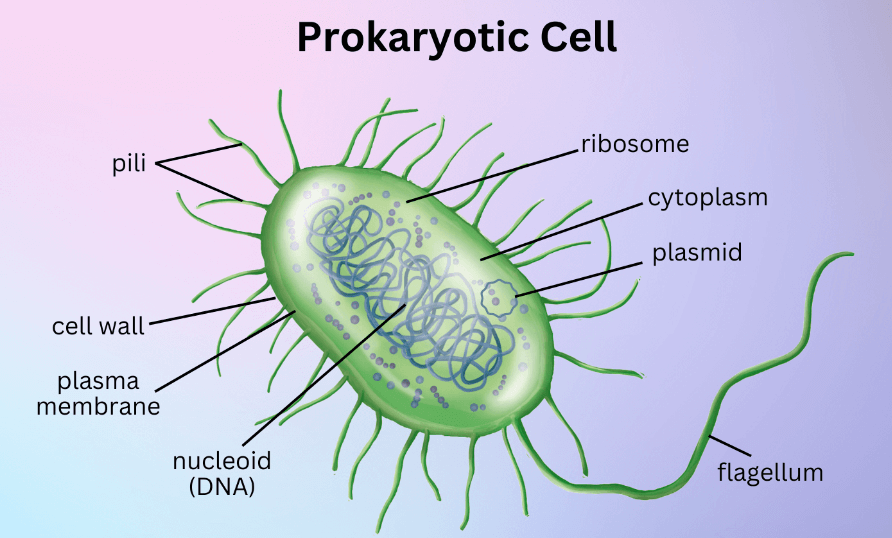
Prokaryotic cells are efficient at important processes like copying DNA, making RNA, and producing proteins in a simple way. These cells mainly consist of four parts: ribosomes, which make proteins; cytoplasm, which is the jelly-like substance inside; plasma membrane, which is the outer layer; and DNA, which carries genetic information.
Prokaryotic Cell Diagram
Here we have shown a well-labeled diagram of a prokaryotic cell. This diagrammatic representation of the prokaryotic cell will help you to understand the prokaryotic cell.
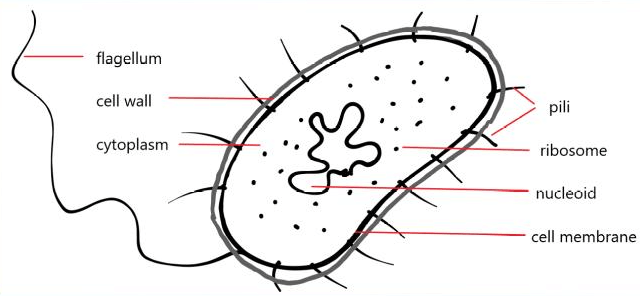
Characteristics of Prokaryotic Cells
Prokaryotic cells have several distinct characteristics and these characteristics make prokaryotic cells distinct from eukaryotic cells and are essential for their adaptation to various environments and roles in processes like digestion, decomposition, and disease.
- Lack of Membrane-Bound Nucleus: Unlike eukaryotic cells, prokaryotic cells do not have a true nucleus. Instead, their genetic material is typically found in a region of the cell called the nucleoid, which lacks a membrane.
- Small Size: Prokaryotic cells are generally smaller than eukaryotic cells, often ranging from 0.5 to 5 micrometers in diameter.
- Simple Structure: They have a relatively simple structure with no membrane-bound organelles like mitochondria, endoplasmic reticulum, or Golgi apparatus.
- Single Circular Chromosome: The genetic material in prokaryotic cells is usually a single, circular DNA molecule located in the nucleoid region.
- Plasmids: Prokaryotes can also have smaller, circular pieces of DNA called plasmids, which often carry genes for specific functions like antibiotic resistance.
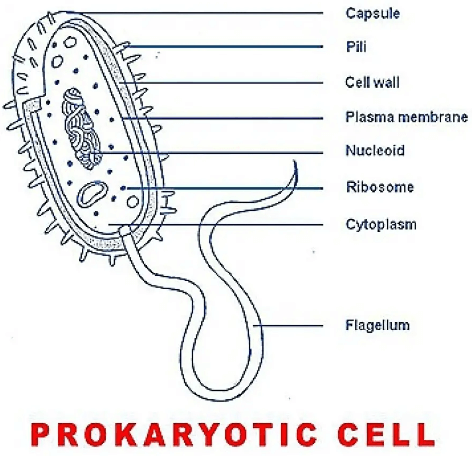
- Ribosomes: They contain ribosomes for protein synthesis, but these ribosomes are smaller (70S) compared to the ribosomes in eukaryotic cells (80S).
- Cell Wall: Many prokaryotic cells have a rigid cell wall outside the cell membrane, which provides structural support and provides structural support and protection.
- Flagella and Pili: Some prokaryotic cells possess flagella for movement and pili for adhesion and conjugation.
- Binary Fission: Prokaryotic cells reproduce through a simple division process called binary fission, where one cell splits into two identical daughter cells.
- Metabolic Diversity: Prokaryotes exhibit a wide range of metabolic capabilities, including photosynthesis, chemosynthesis, and various modes of respiration.
Prokaryotic Cell Structure
The structure of a typical prokaryotic cell has been discussed below. It’s important to note that while these structures are common in many prokaryotic cells, there can be variations in structure and composition among different species of bacteria and archaea. These variations contribute to the diversity and adaptability of prokaryotic microorganisms in various environments.
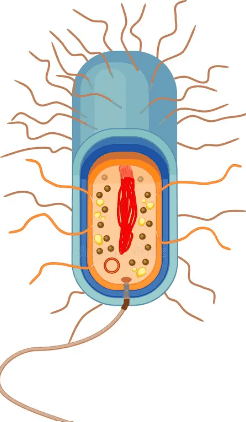
Cell Wall:
Many prokaryotic cells have a rigid cell wall that surrounds the cell membrane. The cell wall provides structural support and protection from the environment. In bacteria, the composition of the cell wall can vary, with some having a peptidoglycan layer (Gram-positive), and others having both an inner and outer membrane with a thin layer of peptidoglycan in between (Gram-negative).
Cell Membrane (Plasma Membrane):
Just beneath the cell wall, prokaryotic cells have a cell membrane that encloses the cytoplasm. It acts as a semi-permeable barrier, controlling the passage of molecules in and out of the cell.
Cytoplasm:
The cytoplasm is the gel-like substance within the cell membrane where various cellular processes occur. It contains enzymes, ribosomes, and the nucleoid region.
Nucleoid:
Instead of a true nucleus, prokaryotic cells have a nucleoid region where the single, circular DNA contains the genetic information necessary for all the cell’s functions.
Ribosomes:
Prokaryotic cells contain ribosomes, which are involved in protein synthesis. These ribosomes are smaller (70s) than the ribosomes found in eukaryotic cells.
Flagella:
Flagella are long, whip-like structures that some prokaryotic cells use for movement. They rotate to propel the cell through its environment.
Pili (Fimbriae):
Pili are shorter, hair-like structures on the cell’s surfaces or other cells, as well as in the transfer of genetic material during conjugation.
Capsule (Optional):
Some prokaryotic cells have a protective outer capsule layer that surrounds the cell wall. The capsule can help the cell evade the host’s immune system.
Cytoplasmic Inclusion:
Prokaryotic cells may contain various inclusions such as granules or storage vesicles that store nutrients or other substances needed by the cell.
Examples of Prokaryotic Cell
Prokaryotic cells are found in various types of microorganisms, including bacteria and archaea. Here we have discussed some examples of organisms that consist of prokaryotic cells:
- Escherichia coli (E. coli): A common bacterium found in the intestines of humans and other animals. It is often used in scientific research.
- Streptococcus pyogenes: This bacterium can cause various infections in humans, including strep throat and skin infections.
- Bacillus anthracis: The causative agent of anthrax, a serious infectious disease that can affect both humans and animals.
- Cyanobacteria: These are photosynthetic prokaryotes that play a crucial role in aquatic ecosystems. They are sometimes referred to as blue-green algae, although they are not true algae.
- Mycobacterium tuberculosis: The bacterium responsible for tuberculosis, is a contagious respiratory disease that can be severe if left untreated.
- Thermophiles: Archaea that thrive in extreme environments, such as high-temperature hot springs. Examples include Thermus aquaticus, which is used in molecular biology for its heat-resistant DNA polymerase enzyme.

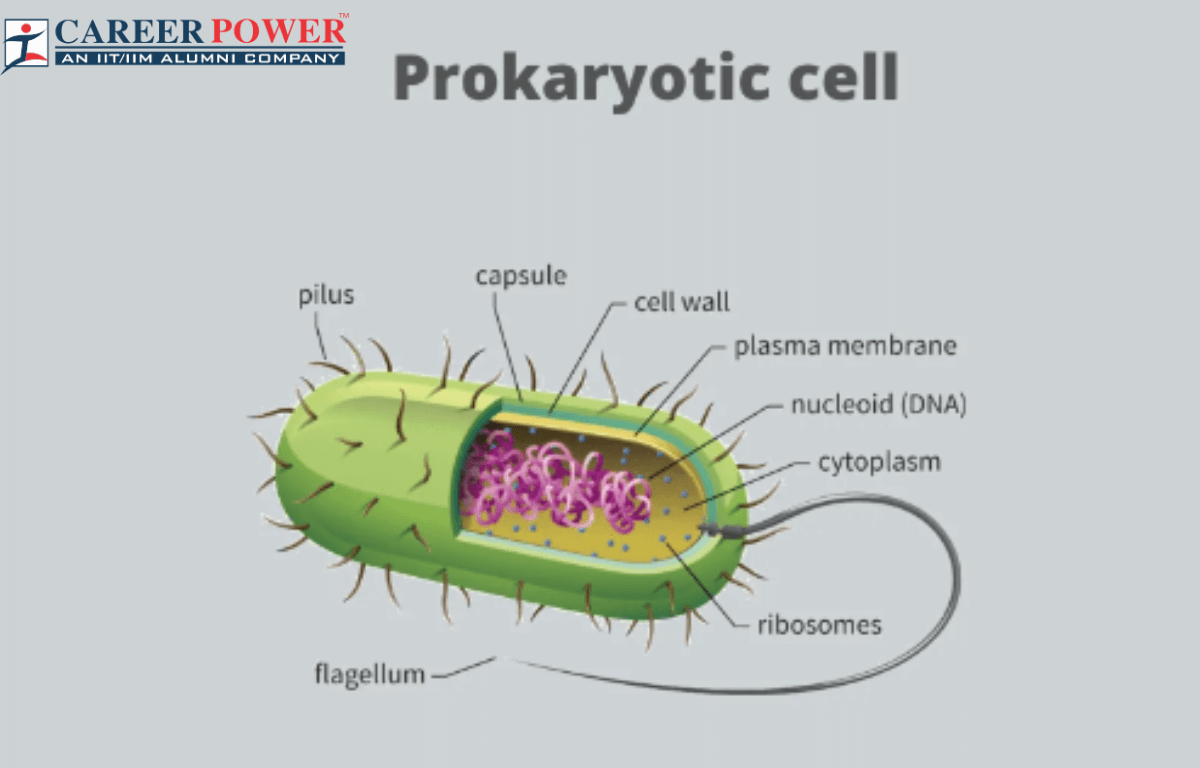

 50 Vegetables Name for Kids in English a...
50 Vegetables Name for Kids in English a...
 Food Chain: Definition, Types, Examples,...
Food Chain: Definition, Types, Examples,...
 Human Respiratory System: Definition, Di...
Human Respiratory System: Definition, Di...













